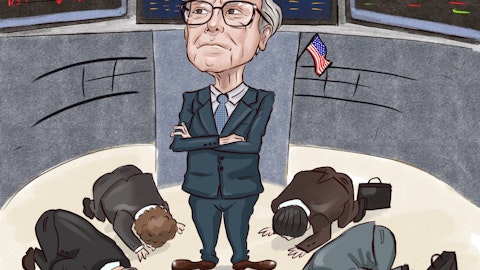Tomer Weingarten: For us it’s a combination of both. We still see ample growth in endpoint, but we’re definitely developing our emerging capabilities. And I think you can see the proportion of the emerging capabilities contribution to revenue is pretty much on par with our peers even though obviously on a different scale. So, we definitely treat that progression as something that we would like to see go and accelerate. But with that, we’re not ceding growth on the endpoint market. We believe there’s ample potential there as I mentioned and it’s something that we are basically trying to run in parallel of emerging growth. Another point that’s worth mentioning while on the topic is that most of our growth actually comes from new accounts.
So, this is not about going back to a customer base or a customer estate and upselling cross-selling. And in that world you have to sell other capabilities. For us. focusing on net new accounts. I mean we lend bigger. we lend with more of the platform and it still represents a major opportunity for us in the future to go back to our customer estate upsell and cross-sell to the other capabilities that we have as well. So, right now, I would really is best of both worlds for us. We’re still strong in endpoint, but we’re also accelerating our adoption and our penetration with these emerging capabilities like data, AI, and cloud security, of course.
Peter Weed: And when you think of kind of the effect on expansion from kind of fee compression on renewals, which I know has been kind of a frustrating thing associated with the macro, is that something where you’re starting to see light at the end of the tunnel where that’s starting to lighten up and we should start seeing some benefits to NRR from there being less drag on that? Or is it still ongoing and it’s hard to predict when that might end?
Tomer Weingarten: NRR for us is still very much an expansionary territory. So, we treat it as something that’s very stable. We like to see that these rates. And once again it points to our desire to continue and amass new logos and new accounts and new market share. So, we don’t feel like NRR right now for us is something that we want to focus on. We’re not as focused in cross-selling to our own estate as we are in winning new market share. So, for us again it’s a natural organic growth in NRR. I think when the time is right, we put more focus on it and I think we can definitely grow it further. For now, I believe that’s the right mixture for us.
Operator: Our next question today is from the line of Saket Kalia of Barclays. Your line is now open, please go ahead.
Saket Kalia: Okay, great. Hey guys, thanks for taking my question here. Tomer maybe for you, I was wondering if you could talk about the enterprise bundle a little bit on the endpoint side. I think that’s your — really your highest-value bundle that combines more than AV and EDR. Especially given some of the commentary on bigger deals and such, how is sort of the reception to that enterprise bundle in the quarter? And how are you kind of thinking about the upsell or cross-sell opportunity in the coming year?
Tomer Weingarten: It has very good traction. We’re definitely seeing our channel partners really take interest in that bundle. And as you mentioned, I mean it’s endpoint, it’s EDR capabilities, it’s MDR, it’s vulnerability management, it’s remote operations, it’s data retention. There’s a lot in that bundle, so it’s something that does help us drive I think what you’re seeing in Q4, which is ARR per customer landing bigger. But with that, it doesn’t cannibalize the other capabilities that we have, especially the more formidable product line like cloud security, like data ingestion capabilities versus data retention. So we felt that it’s a highly strategic bundle for us to really go and lend bigger, deliver more value for the customer.
I think it’s less about just trying to put more capabilities to drive the price up. It’s really about creating a great outcome for the customer, more and more consolidation of nascent capabilities in their environment, which are getting out of the box with the enterprise bundle. So partners like it, customers like it, these things take time to get to full production let’s say, so Complete is still very much the bundle that is leading the charge for us. But with that we’re definitely seeing a mix shift to enterprise. It has good traction. We expect that to continue.
Operator: Thank you. Our next question today is from the line of Ray McDonough of Guggenheim. Your line is now open. Please go ahead.
Ray McDonough: Great. Thanks for taking the question. Tomer, outside of one of your competitors giving away some capabilities for free, we have been hearing from partners that security deals in general are becoming more creative given the persistent challenging macro environment. So my question is, how are some of the larger deals you mentioned structured? Are they increasingly becoming more creative with ramp deals or other incentives to drive adoption? And maybe Dave, if you want to comment on how any different structures might be impacting the model at all, if we’re not seeing the full impact of maybe an increase in ramp deals or anything like that would be helpful.





